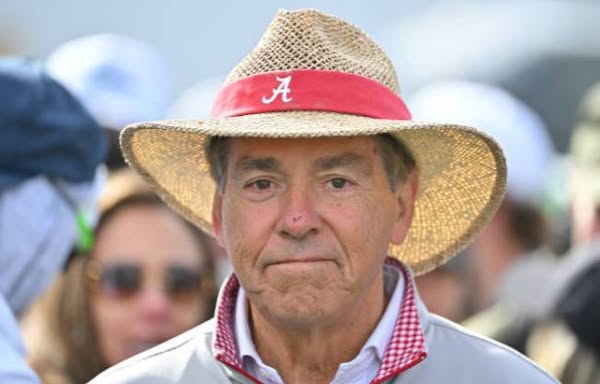When the news broke, it shook the heartbeat of Tuscaloosa: Nick Saban is coming back to revive the Alabama Crimson Tide and lead us to victory once more. The man whose voice became synonymous with discipline, excellence and national championships is not returning merely as an icon on the sidelines—he’s back to take control again, and he couldn’t be more resolute: “I am Coming Back to Revive the Team and See Us Win Again.” In mid‑2025, the legend has returned, and if the seismic reaction across the SEC is any indication, the dynasty is far from over.
It all started with a whisper in the corridors of Bryant‑Denny Stadium. First came murmurs of informal conversations: Saban consulting with incoming coach Kalen DeBoer, guiding recruiting strategy, offering mentorship. Then came the announcement: Saban would serve as General Manager (some reports call him Executive Head Coach or Program Architect)—a revolutionary front‑office role tailored to the complexity of modern college football . The label may vary, but the mission is clear: He’s here to build from within—the “football godfather,” shadow CEO, the man directing every shot behind the scenes .
Nick Saban walked through those stadium gates as though he had never left. Fans flooded social media and rallied outside campus in droves. “It’s like Christmas came early,” a student told ESPN . Across the SEC, rival coaches convened to assess the renewed threat posed by Alabama—one joked that “It’s like Darth Vader came back from the Death Star and joined the board” . It really did feel apocalyptic for opponents—and celebratory for Tide faithful.
Saban’s own words strike with unmistakable intent: “The program means everything to me. I’m here to help, support the players and coaches.” He’s not interested in being a figurehead. He’s back to fight—to recruit elite roster talent, manage NIL deals, orchestrate scholarships, mentor future NFL prospects, and collaborate on strategic infrastructure . “We’re not here for rebuilds. We’re here for championships,” he declared .
To the uninitiated, a retired coach returning—even in executive position—might raise eyebrows. But Nick Saban has never been ordinary. He has always believed the Tide needed complete control: a unified vision, a squad marching in formation, no extraneous voices obstructing his mission . His previous retirement in January 2024 came with a promise: “There’s life after football…but I’m always going to be here for Alabama however they need me.” . Now he’s not merely present—he’s leading again.
For the man who pioneered “the Process”—a system so meticulous it became legendary—it’s natural that he would return to set the standards once more. In his previous run from 2007 to 2023 Saban built one of history’s greatest football dynasties: six national championships, nine SEC titles, over 200 wins, a conveyor belt of All-Americans and Heisman winners (Ingram, Henry, Smith, Young), 47 NFL first-rounders, and a culture defined by relentless discipline . That foundation hasn’t been forgotten—it’s been reinforced by the memory of an era when Alabama dominated absolutely.
Under head coach Kalen DeBoer, who succeeded Saban in early 2024, Alabama recorded a solid 9‑4 season and a bowl appearance—the program’s hope, but not crisis . Yet whispers grew about a drop in recruiting momentum, uncharacteristic staff instability, and player transfers—an apparent longing for the clarity of Saban’s reign . That buzz crescendoed when the hire was formalized: Saban would assume a GM‑style role, sitting atop football operations and providing executive oversight.
If analysts were questioning legitimacy, Saban’s record speaks all its own: A 201–29 record at Alabama, six titles, and he transformed Tuscaloosa into a mecca. The spring scrimmage of 2007 saw 92,000 fans pack Bryant‑Denny—an open‑practice spectacle you’d expect only on game day . He built the Saban Standard—comprehensive facilities expansions, trophy showcases, NIL infrastructure, and the expectation that championships are the only acceptable outcome . College football today—with transfer portals and NIL complexities—demands savants who can operate both on the field and behind the scenes. And Saban is tailor-made for that era.
What does this mean in practice? First, recruiting: Saban’s presence has an instant gravitational pull on five-star prospects. The 2025 class was already strong—but now top recruits are reconsidering commitments . Second, NIL strategy: The GM role includes oversight of deals, compliance, leverage, and long-term athlete marketing frameworks . Third, staff management and development: Saban will vet hires, calibrate schemes, and ensure that no coordinator strays from program values . Fourth, mentoring leadership: He’ll nurture DeBoer, groom staff and player leadership, and act as philosophical steward .
Kalen DeBoer has been public in his excitement: “Coach Saban is a mentor, a resource and a legend,” he said. “His return only strengthens our mission—to chase excellence in everything we do.” . Their relationship seems symbiotic: DeBoer steers the ship on game days; Saban ensures the hull is watertight, the sails trimmed, and the compass pointed true. It’s a pairing that rivals the greatest NFL GM‑coach duos—and it signals a shift in college football’s hierarchy.
This is not simply Alabama nostalgia. This is a robust strategic shift. Modern college football demands silo‑shattering leadership: recruiting, NIL management, transfer‑portal savvy, analytics, mental health, alumni relations, booster alignment, donor coordination, facility upgrades. No single coach could—or should—manage all that and still coach games. Thus, Alabama is rewiring: Saban in the GM role, DeBoer calling plays, and an ecosystem built on clarity and shared goals .
The SEC couldn’t absorb the news quietly. Fans of Georgia, LSU, Texas A&M, and even Florida State scrambled to figure out how to counter this leviathan. Even outside observers are talking about the competitive imbalance. One commentator opined that “Alabama just reloaded in the most terrifying way possible” . The implicit message: this resurgence could reset the definition of dominance in college football.
For players—veterans like quarterback Jalen Milroe and incoming freshmen—this is a résumé-building moment. The opportunity to learn under DeBoer with Saban influencing facility upgrades, training regimens, scouting visits, and personal mentorship is priceless . Professional scouts will note that Saban‑developed players thrive in the NFL.
For Alabama fans, it’s validation of hope. The 2025 season kickoff feels different. Season ticket sales skyrocketed, podcasts dedicated to “Saban 2.0” sprung up overnight, and campus energy is crackling. This is a man who promised championships and delivered on them. And now, with the bully pulpit, he is stating in plain terms: “I am Coming Back to Revive the Team and See Us Win Again.”
In an era where college athletics is buffeted by NIL turbulence, transfer-portal churn, conference realignment, and expanding playoffs, one thing remains immutable: culture matters. Nick Saban built a culture of winning. He saw a program drift and chose not to watch from the sidelines. He chose to take the wheel again. This is not retirement reimagined—it’s dominance recalibrated.
Imagine the spring camp: Saban surveying drills, DeBoer signaling plays, high-profile recruits walking through newly minted NIL partnerships. Envision off‑season leadership retreats, booster meetings led by Saban’s strategic ethos, analytics dashboards reviewed by his keen eye. Imagine the repeat of 2009‑14—but in 2025‑? That’s not speculation—that’s vision.
No wonder ESPN’s Paul Finebaum called him a “football godfather.” And why Alabama President Stuart Bell said: “He built an empire. Now he’s returning to help protect it, guide it and elevate it.” This is more than a hire. It’s the preservation—and evolution—of a dynasty.
Political consultants, CEOs and military leaders who study branding would find a case study here: Saban steps away at 72, retires on his own terms, enjoys silence… and returns with refreshed ambition in a uniquely tailored role that matches 2025’s college football demands. A day later, the Tide Nation still buzzes.
It begs questions: Will other powerhouses replicate this model? Will head coaches shift into GM roles under successors? Is college football morphing into pro-style front-office structures? Possible. But one thing is certain: No school hired a figure more equipped to lead that revolution than Alabama.
As kickoff approaches, one thing looms large: the return of Nick Saban isn’t just a story. It’s a pronouncement. “I am Coming Back to Revive the Team and See Us Win Again.” And with him, Alabama isn’t dreaming—it’s planning.
If titles are won with vision and strategy, Alabama has regained the architect. If championships are earned with culture and discipline, they have reclaimed the masterbuilder. If the winning standard is the ultimate goal, then Saban 2.0 means Crimson Tide Nation knows exactly what to expect.
The legend is back, the empire is reassembled, the goal is clear: win again. The rest of college football should prepare accordingly.



